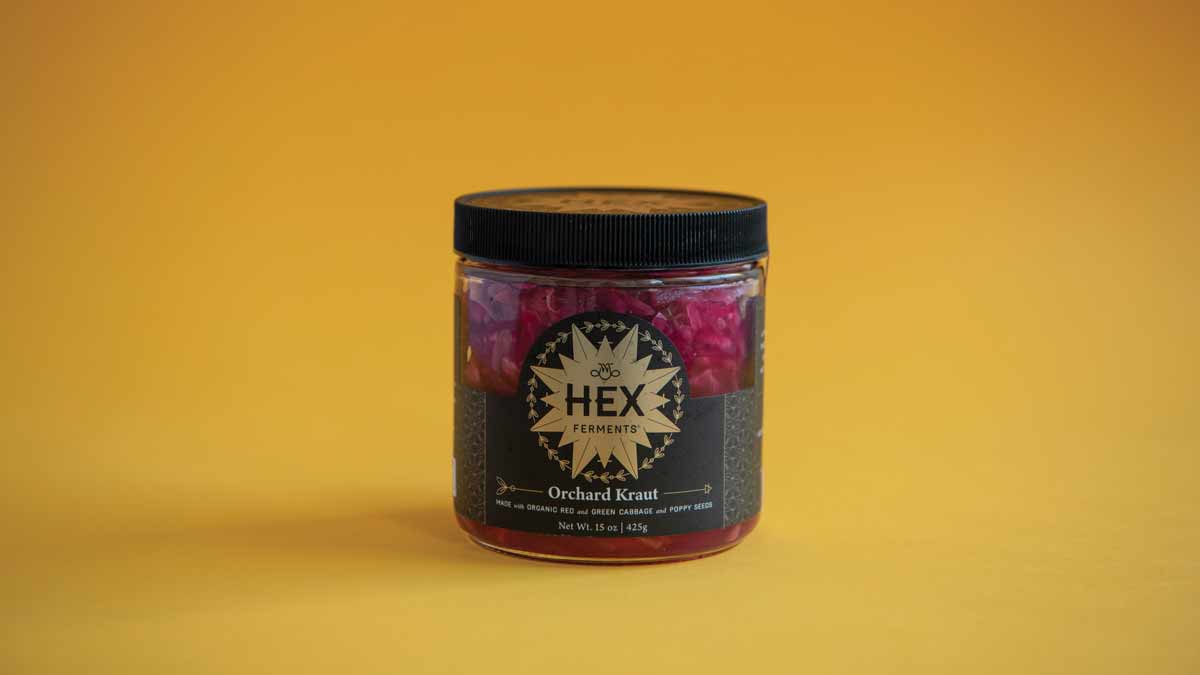Fermented
FOOD

To learn more I chatted with my friend Meaghan Carpenter, an honest to goodness “Food Alchemist,” and co-founder of Hex Ferments.
What are fermented foods?
Fermentation is a process of microbial transformation that can be achieved using sea salt for vegetable ferments, a culture (like kombucha and kefir), an active starter like sourdough or yogurt, or inoculated and left to grow like koji spores on rice for miso.” What is created is a “living food,” which contains live, healthy bacteria or probiotics.
The fermentation process for veggies involves cutting or shredding to create surface area, and adding salt, “which releases water and exposes the sugars and nutrients that the lactobacillus bacteria need to grow and thrive. In a short time the vegetables transform into tangy, nutrient-dense and probiotic-rich sauerkraut, kimchi or pickles.
Why are fermented foods important?
They make anything you are eating instantly more bioavailable. There is a reason why you get a pickle with your sandwich or kraut on a hot dog. Fermented vegetables help our bodies to break down fats, nutrients and coat our digestive organs with beneficial bacteria that will make digestion and assimilation quicker and more efficient.
They are important for healthy gut bacteria, which is important for a healthy immune system, and even impacts mood. “90% of our immune system and serotonin is produced in our gut. Both are impacted by our gut bacteria. The more of a diverse bacterial environment you have in your body, the stronger your immune system. And it will help keep you happy! (Serotonin is the ‘feel good’ brain chemical.)
And they add fiber, vitamins and minerals that are already pre-digested. Think of your gut as a lush rainforest that you need to keep in balance with daily doses of delicious sauerkrauts, kimchi and kombucha tea. The more lush your forest the better you feel. So when you are feeling over-indulged, bloated, hungover etc. reach for a bite of sauerkraut or kombucha.
Not all fermented foods are created equal
To get the benefits of “living food” look for fermented vegetables that have been made using just sea salt and left unpasteurized. This ensures that the process has been done traditionally and not using a shortcut like vinegar. Look for the words “naturally fermented” on the label, and for telltale bubbles in the liquid when you open the jar.
Or make your own! Here’s a recipe from Hex Ferments for a quick Local Winter Kraut:
INGREDIENTS:
- 5 pounds green cabbage
- 2 pounds napa cabbage
- 3 medium carrots
- 5 small red turnips
- 1 small onion
- 1 Bosc pear or apple
- 5 cloves garlic, minced
- 2 tablespoons grated ginger with skin
- 1 orange juiced, approximately ¼ cup
- 1 to 2 teaspoons dried pepper or to taste (Espelette, cayenne, or jalapeño)
- 4 to 6 tablespoons coarse sea salt (taste after 4, then salt to taste)
DIRECTIONS:
- Wash produce well, and remove any bad parts. Reserve 5 to 6 outer cabbage leaves, set aside. Cut cabbage into 4 sections, and remove the core. Slice produce into thin, bite-sized pieces.
- Place everything in a large bowl, add salt, spices (wear gloves if adding hot pepper!) and orange juice. Mix and massage with your hands. Squeeze! Work those veggies! Work salt into the produce well to release the water and create a brine.
- Once a nice pool of brine has collected in the bottom of the bowl, approximately 2 to 3 cups, pack vegetables into a clean, 2-gallon crock or wide-mouth glass container. Be sure to push down with your hands to remove air pockets. After all vegetables are packed in to the jar, press down well so that the brine covers the surface, creating an anaerobic environment. Layer reserved cabbage leaves onto the surface of the kraut. Place a weight (a plate topped with a jar filled with water works well) over the surface, cover the top of the vessel with a clean towel and secure with a rubber band. Kraut should be covered in its brine with room at the top of the vessel to allow for expansion over the first few days of active fermentation.
- Date outside of the vessel and place in a location that is away from direct sunlight, and maintains a relatively even temperature; 64-72 degrees is ideal, higher temperatures will speed up fermentation, cooler temperatures will slow it down.
- After 5 to 10 days, active fermentation will slow as lactic acid bacteria begin to take up residence. Kraut will continue to ferment vegetables into sour, tangy Winter Kraut. At this point, jar up kraut into smaller portions and refrigerate or take what you want from crock and enjoy its flavorful changes until it’s all gone.
Different types of fermented foods
Kombucha: a fermented sweetened black or green tea drink
Kvass: fermented sauerkraut or beet juice. In slavic cultures it is made from rye bread.
Yogurt/Kefir: milk fermented by added bacterias
Kimchi: Korean salted and fermented vegetables (usually napa cabbage and Korean radish)
Sauerkraut: finely-cut raw cabbage fermented by lactic acid bacteria.
Miso/Tempeh/Natt: fermented soybean products
Sourdough: bread made with fermented dough using naturally occurring lactobacilli and yeast
Olives: brine cured and naturally fermented
Pickles: vegetables fermented in brine (not vinegar)
Meaghan Carpenter is a “Food Alchemist” and Co-Founder of HEX Ferments, an award-winning, Baltimore-based fermented foods company. HEX Ferments specializes in creating living foods (sauerkrauts, kimchi, pickles and Kombucha) from local-organic and sustainably grown ingredients. HEX Ferments was born from a performance art piece that was a collaboration with her photographer husband. The concept of the art-piece touched on her pursuits of (re)creating gut-healthy communities centered on local food and delicious edible art. HEX Ferments has been nationally and internationally recognized for its creations, sustainability practices, fermentation education and advancing the frontier of the fermented arts.
Find them at https://www.hexferments.com/pages/find-us
